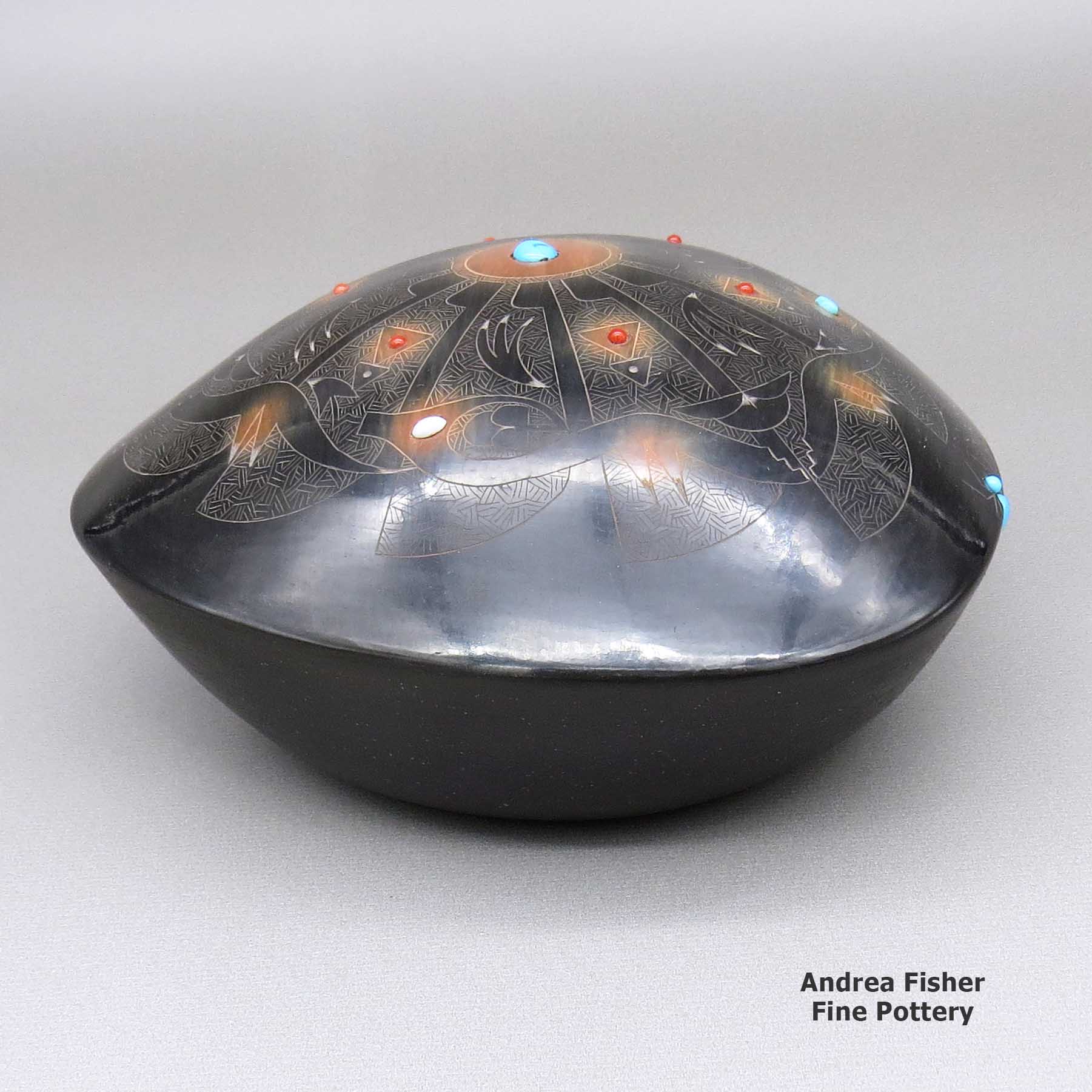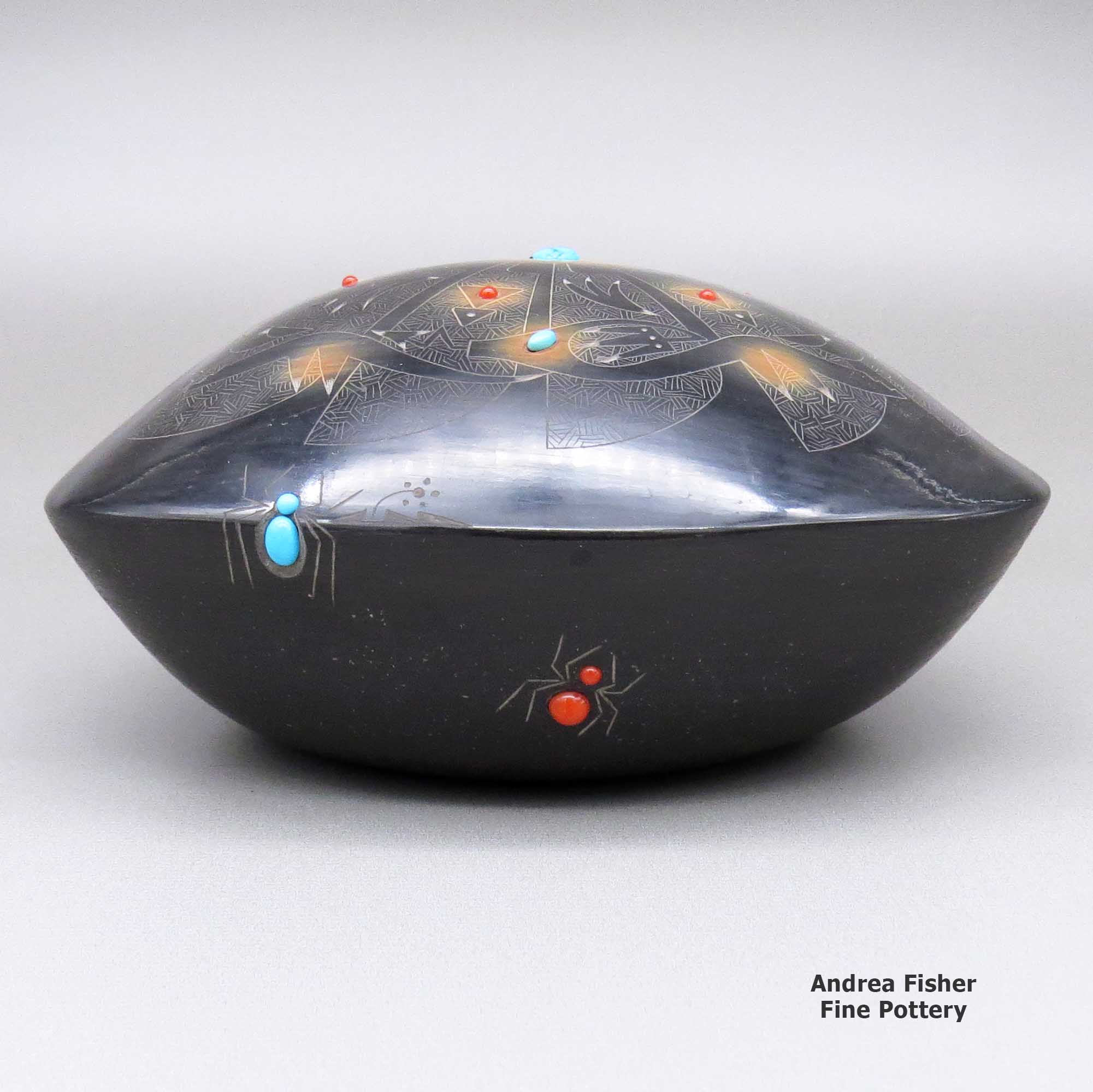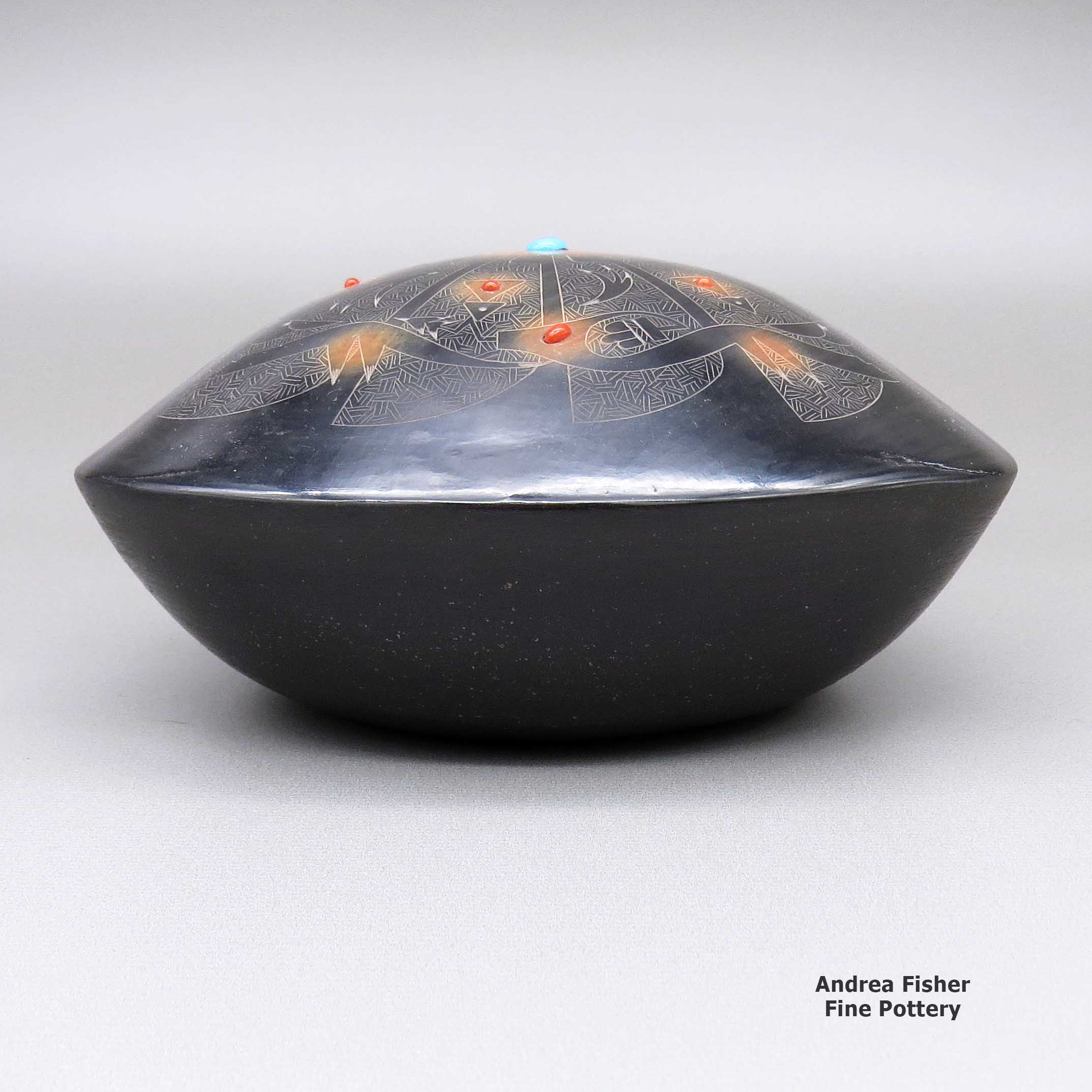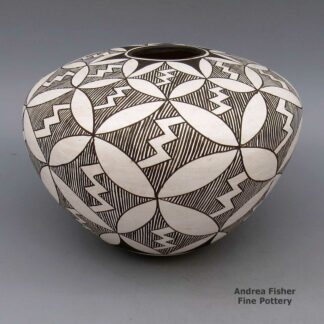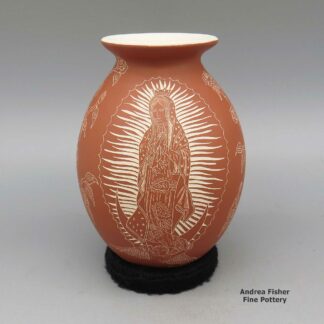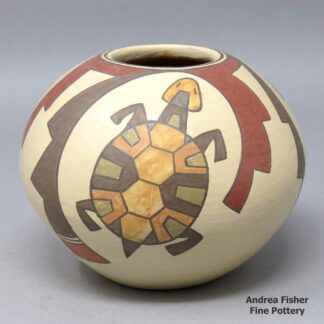| Dimensions | 6.25 × 6.25 × 3.25 in |
|---|---|
| Condition of Piece | Very good |
| Signature | Tahn-Moo-Whe, with raincloud and lightning bolt hallmark |
Barbara Gonzales, zzsi3b549, Seed pot with sienna spots and a sgraffito geometric design
$2,850.00
A black seed pot with sienna spots, decorated with a sgraffito ring of avanyus, ring-of-feathers and geometric design, plus with inlaid stone details
In stock
Brand
Gonzales, Barbara
She credits her great-grandmother with changing the making of pottery from a craft to a fine art. Barbara also credits her great-grandmother with being a major force in the shaping and evolution of that fine art.
Barbara lived in Maria's home at San Ildefonso Pueblo from the time she was five until she was ten. That is when she learned the basics of the traditional way of making pottery. Barbara says pottery making was such an integral part of Maria's family life that she organically assimilated the skills simply by being in the presence. She also traveled with Maria to sell pots to tourists under the portal at the Palace of the Governors in Santa Fe and at the train depot in Albuquerque.
Barbara's own first pieces were simple animal sculptures. She progressed into small jars, then bowls and spheres. Slowly Barbara developed her style of small sculptures, polychrome pottery and stone-inlaid, sgraffito-etched red and black ware.
Along with Popovi Da she was one of the early adopters of the two-tone technique (involving two firings to produce sienna effects on otherwise black pots). She also used inlaid turquoise, heishe beads and gemstones. Around 1973 she originated "the Spider" and "the webbing technique" in sgraffito-on-black pottery. That design pattern soon became her trademark.
Barbara participated in the Santa Fe Indian Market for many years, earning First, Second and Third Place ribbons often. She was included in the Maria Martinez: Five Generations of Potters exhibition at the Renwick Gallery in 1978 and the Masters of Indian Market exhibition at the Santa Fe Indian Market in 1996.
Barbara was chosen as a representative of Maria's "craft lineage" in the 1997-8 Pottery by American Indian Women, The Legacy of Generations exhibition of the National Museum of Women in the Arts.
Some of the Awards Barbara has earned
- 2000 Santa Fe Indian Market, Classification II - Pottery, Division H - Non-traditional pottery, any forms using non-traditional materials or techniques, Category 1520 - Miscellaneous, unpainted: Second Place
- 1996 Santa Fe Indian Market, Classification II - Pottery, Division H - Non-traditional any forms using non-traditional materials or techniques, Category 1510 - Single figures, (animal & other), all other: First Place
- 1995 Santa Fe Indian Market, Classification II - Pottery - Division E - Traditional pottery, painted designs on burnished black or red surface: Best of Division
- 1995 Santa Fe Indian Market, Classification II - Pottery - Division E - Traditional pottery, painted designs on burnished black or red surface, Category 1203 - Bowls, over 6 inches in diameter: First Place
- 1995 Santa Fe Indian Market, Classification II - Pottery - Division E - Traditional pottery, painted designs on burnished black or red surface, Category 1206 - Plates: Third Place
- 1995 Santa Fe Indian Market, Classification II - Pottery - Division E - Traditional pottery, painted designs on burnished black or red surface, Category 1207 - Miscellaneous: First Place
- 1990 Santa Fe Indian Market, Classification II - Pottery, Division J - Non-traditional, any forms using non-traditional materials or techniques, Category 1403 - Jars & vases, unpainted (other than stoneware): Second Place
- 1988 Gallup InterTribal Ceremonial, Classification IV - Pottery-jar, seed jar, canteen: Third Place
- 1983 Santa Fe Indian Market, Classification II - Pottery, Division E - Traditional, painted designs on burnished black or red surface: Second Place
- 1977 Heard Museum Guild Indian Arts & Crafts Exhibit, Classification VII - Pottery, Division C - Miniatures, under 2-1/2": Second Place
- 1974 12th Annual Scottsdale National Indian Arts Exhibition, Section C - Crafts, Classification VIII - Pottery, Division B - Adaptations: Honorable Mention
A Short History of San Ildefonso Pueblo
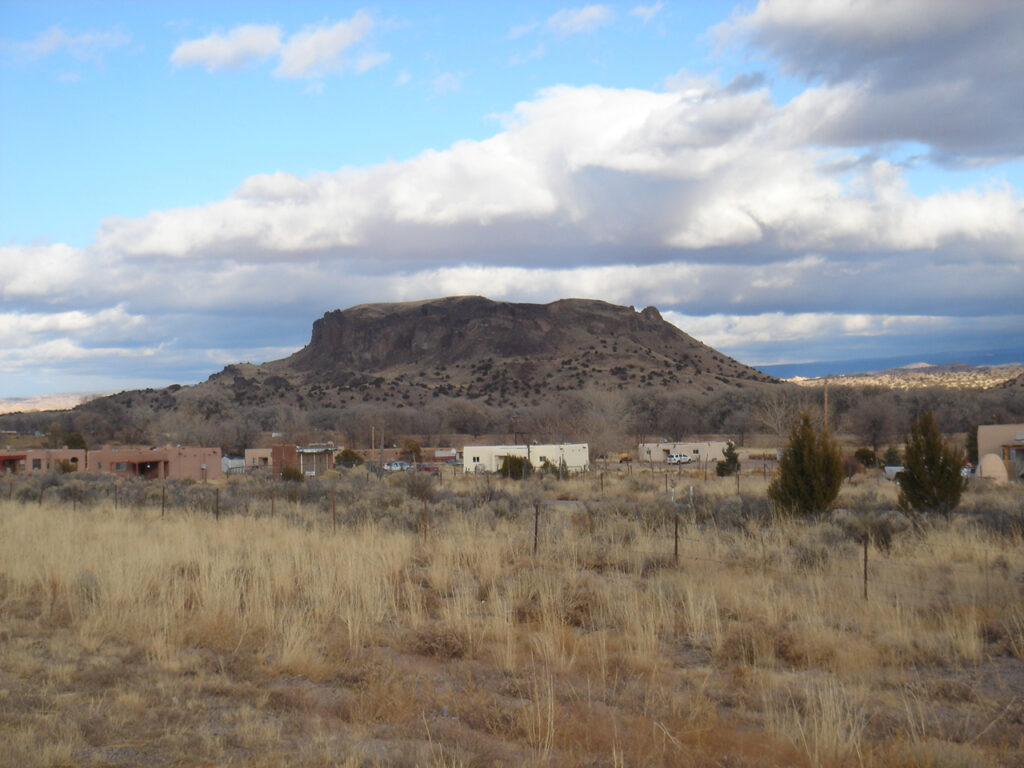
San Ildefonso Pueblo is located about twenty miles northwest of Santa Fe, New Mexico, mostly on the eastern bank of the Rio Grande. Although their ancestry has been traced as far back as abandoned pueblos in the Mesa Verde area in southwestern Colorado, the most recent ancestral home of the people of San Ildefonso is in the area of Bandelier National Monument, the prehistoric village of Tsankawi in particular. The area of Tsankawi abuts today's reservation on its northwest side.
The San Ildefonso name was given to the village in 1617 when a mission church was established. Before then the village was called Powhoge, "where the water cuts through" (in Tewa). The village is at the northern end of the deep and narrow White Rock Canyon of the Rio Grande. Today's pueblo was established as long ago as the 1300s and when the Spanish arrived in 1540 they estimated the village population at about 2,000.
That first village mission was destroyed during the Pueblo Revolt of 1680 and when Don Diego de Vargas returned to reclaim the San Ildefonso area in 1694, he found virtually the entire tribe on top of nearby Black Mesa, along with almost all of the Northern Tewas from the various pueblos in Tewa Basin. After an extended siege, the Tewas and the Spanish negotiated a treaty and the people returned to their villages. However, the next 250 years were not good for any of them.
The Spanish swine flu pandemic of 1918 reduced San Ildefonso's population to about 90. The tribe's population has increased to more than 600 today but the only economic activity available for most on the pueblo involves the creation of art in one form or another. The only other jobs are off-pueblo. San Ildefonso's population is small compared to neighboring Santa Clara Pueblo, but the pueblo maintains its own religious traditions and ceremonial feast days.

Photo is in the public domain
About the Seed Pot
It was a matter of survival to the ancient Native American people that seeds be stored properly until the next planting season. Small, hollow pots were made to ensure that the precious seeds would be kept safe from moisture, light, bugs, reptiles and rodents.
After seeds were put into the pot, the small hole in the pot was plugged. The following spring the plug was removed and the seeds were shaken from the pot directly onto the planting area.
Today, seed pots are no longer necessary due to readily available seeds from commercial suppliers. However, seed pots continue to be made as beautiful, decorative works of art.
The sizes and shapes of seed pots have evolved and vary greatly, depending on the vision of Clay Mother as developed through the artist. The decorations vary, too, from undecorated white, buff or red seed pots to multi-colored painted, carved, applique and sgraffito designs, sometimes with inlaid gemstones, micaceous clay and silver or clay lids.
Because of the multitude of shapes and sizes, the name "seed pot" is generally reserved for pieces with tiny openings.
About Inlays
Inlays are a relatively recent development in the world of Native American pottery. To make an inlay, it is necessary to carve a close-fitting groove or notch on a piece in which to set the inlay. Then the piece is fired and once cooled, whatever the inlay material is, it is glued in place.
Often, the inlay is composed of a cabuchon of turquoise or other semi-precious stone, or perhaps a piece of coral. Sometimes it is a strand (or strands) of heishe beads. Sometimes it is a small piece of sculpted silver, like Preston Duwyenie's Shifting Sands designs.
Ramona Gonzales Family Tree - San Ildefonso Pueblo
Disclaimer: This "family tree" is a best effort on our part to determine who the potters are in this family and arrange them in a generational order. The general information available is questionable so we have tried to show each of these diagrams to living members of each family to get their input and approval, too. This diagram is subject to change should we get better info.
-
Ramona Sanchez Gonzales (1885-), second wife of Juan Gonzales (painter)
- Rose (Cata) Gonzales (daughter-in-law)(1900-1989)(San Juan) & Robert Gonzales (1900-1935)
- (Johnnie) Tse-Pe (Gonzales)(1940-2000) & Dora Tse-Pe (Gachupin, first wife, Zia, 1939-)
- Andrea Tse Pe (1975-)
- Candace Tse-Pe (1968-)
- Gerri Tse-Pe (1963-)
- Irene Tse-Pe (1961-)
- Jennifer Tse-Pe (1966-1983)
- (Johnnie) Tse-Pe (1940-2000) & Jennifer Tse Pe (Sisneros - second wife, Santa Clara)
- Marie Gonzales-Kailahi & James Kailahi
- (Johnnie) Tse-Pe (Gonzales)(1940-2000) & Dora Tse-Pe (Gachupin, first wife, Zia, 1939-)
- Blue Corn (Crucita Gonzales Calabaza)(1921-1999)(step-daughter of Ramona) & Santiago Calabaza (Santo Domingo) (d. 1972)
- Heishi Flower (Diane Calabaza-Jenkins) (1955-)
- Joseph Calabaza (Tha Mo Thay)
- Elliott Calabaza
- Lucille Calabaza-King
- Nancy Calabaza
- Sophia Calabaza
- Stacey Calabaza
- Krieg Kalavaza
- Vera Solomon (Laguna)
Rose' students: - Juanita Gonzales (1909-1988) & Louis Wo-Peen Gonzales (brother of Rose Gonzales husband)
- Adelphia Martinez (1935- )
- Lorenzo Gonzales (1922-1995)(adopted by Louis & Juanita) & Delores Naquayoma (Hopi/Winnebago)
- Jeanne M. Gonzales (1959-)
- John Gonzales (1955-)
- Laurencita Gonzales
- Linda Gonzales
- Marie Ann Gonzales
- Raymond Gonzales
- Robert Gonzales (1947-) & Barbara Tahn-Moo-Whe Gonzales (1947-)
- Aaron Gonzales (1971-)
- Brandon Gonzales (1983-)
- Cavan Gonzales (1970-)
- Derek Gonzales (1986-)
- Oqwa Pi (Abel Sanchez)(1899-1971) & Tomasena Cata Sanchez (Rose' sister) (1903-1985)
- Skipped generation
- Russell Sanchez (1966-)
- Skipped generation

